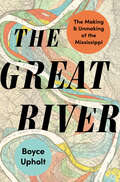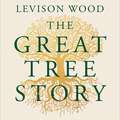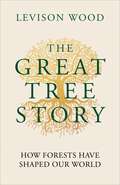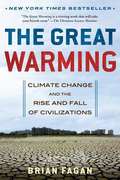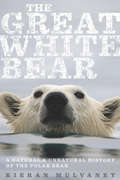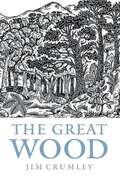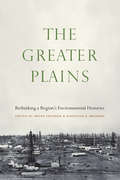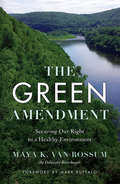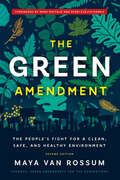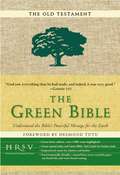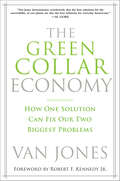- Table View
- List View
The Great River: The Making and Unmaking of the Mississippi
by Boyce UpholtA sweeping history of the Mississippi River—and the centuries of human meddling that have transformed both it and America. The Mississippi River lies at the heart of America, an undeniable life force that is intertwined with the nation’s culture and history. Its watershed spans almost half the country, Mark Twain’s travels on the river inspired our first national literature, and jazz and blues were born in its floodplains and carried upstream. In this landmark work of natural history, Boyce Upholt tells the epic story of this wild and unruly river, and the centuries of efforts to control it. Over thousands of years, the Mississippi watershed was home to millions of Indigenous people who regarded “the great river” with awe and respect, adorning its banks with astonishing spiritual earthworks. The river was ever-changing, and Indigenous tribes embraced and even depended on its regular flooding. But the expanse of the watershed and the rich soils of its floodplain lured European settlers and American pioneers, who had a different vision: the river was a foe to conquer. Centuries of human attempts to own, contain, and rework the Mississippi River, from Thomas Jefferson’s expansionist land hunger through today’s era of environmental concern, have now transformed its landscape. Upholt reveals how an ambitious and sometimes contentious program of engineering—government-built levees, jetties, dikes, and dams—has not only damaged once-vibrant ecosystems but may not work much longer. Carrying readers along the river’s last remaining backchannels, he explores how scientists are now hoping to restore what has been lost. Rich and powerful, The Great River delivers a startling account of what happens when we try to fight against nature instead of acknowledging and embracing its power—a lesson that is all too relevant in our rapidly changing world.
The Great Transition
by Bruce CampbellIn the fourteenth century the Old World witnessed a series of profound and abrupt changes in the trajectory of long-established historical trends. Transcontinental networks of exchange fractured and an era of economic contraction and demographic decline dawned from which Latin Christendom would not begin to emerge until its voyages of discovery at the end of the fifteenth century. In a major new study of this 'Great Transition', Bruce Campbell assesses the contributions of commercial recession, war, climate change, and eruption of the Black Death to a far-reaching reversal of fortunes from which no part of Eurasia was spared. The book synthesises a wealth of new historical, palaeo-ecological and biological evidence, including estimates of national income, reconstructions of past climates, and genetic analysis of DNA extracted from the teeth of plague victims, to provide a fresh account of the creation, collapse and realignment of Western Europe's late medieval commercial economy.
The Great Transition: Shifting from Fossil Fuels to Solar and Wind Energy
by Lester R. Brown Emily Adams Janet Larsen J Matthew RoneyThe great energy transition from fossil fuels to renewable sources of energy is under way. As oil insecurity deepens, the extraction risks of fossil fuels rise, and concerns about climate instability cast a shadow over the future of coal, a new world energy economy is emerging. The old economy, fueled by oil, natural gas, and coal is being replaced with one powered by wind, solar, and geothermal energy. The Great Transition details the accelerating pace of this global energy revolution. As many countries become less enamored with coal and nuclear power, they are embracing an array of clean, renewable energies. Whereas solar energy projects were once small-scale, largely designed for residential use, energy investors are now building utility-scale solar projects. Strides are being made: some of the huge wind farm complexes under construction in China will each produce as much electricity as several nuclear power plants, and an electrified transport system supplemented by the use of bicycles could reshape the way we think about mobility.
The Great Tree Story: How Forests Have Shaped Our World
by Levison Wood'A thrilling journey of discovery' -- Tristan Gooley, author of How to Read a Tree'Levison Wood has done the impossible. To tell the story of trees in a single book is a Herculean task, but one that he has resoundingly achieved.' -- Merlin Hanbury-Tenison, author of Our Oaken Bones'A thrilling, moving, and convincing journey through the life of trees.' -- Will Storr, author of The Status Game'This powerful book brims with curiosity, original thought, and cutting-edge research, but amidst the wonder, you can also hear the haunting 'cry' of the natural world.' -- Sophy Roberts, The Lost Pianos of Siberia Levison Wood has spent a lifetime exploring wild places and witnessing environmental challenges and conservation efforts around the world. Now, he's delving into the incredible world of forests. In this global investigation, The Great Tree Story explores the profound influence forests have had on our planet and civilisation. Each chapter digs into a different aspect of this relationship, from the evolutionary history of trees and their cultural significance in ancient civilisations, to the impacts of agriculture, colonisation, and the industrial revolution on forest ecosystems. The book highlights the wisdom of indigenous communities in forest stewardship, examines the environmental movement's efforts to protect forests, and analyses the causes and consequences of deforestation and environmental degradation.Forests are integral components of the global ecosystem. They serve as complex habitats for flora and fauna, supporting a delicate web of interdependence that we have only scratched the surface of understanding. Every organism, from the towering trees to the smallest insects, plays a crucial role in maintaining the biodiversity that sustains our planet. The intricate relationships woven within forests are not to be underestimated, for they are the threads that hold our world together.In this compelling weaving of fascinating anecdotes and in-depth research, Wood contemplates the future of forests, emphasising the importance of collective action and individual responsibility in preserving these vital ecosystems.
The Great Tree Story: How Forests Have Shaped Our World
by Levison Wood'A thrilling journey of discovery' -- Tristan Gooley, author of How to Read a Tree'Levison Wood has done the impossible. To tell the story of trees in a single book is a Herculean task, but one that he has resoundingly achieved.' -- Merlin Hanbury-Tenison, author of Our Oaken Bones'A thrilling, moving, and convincing journey through the life of trees.' -- Will Storr, author of The Status Game'This powerful book brims with curiosity, original thought, and cutting-edge research, but amidst the wonder, you can also hear the haunting 'cry' of the natural world.' -- Sophy Roberts, The Lost Pianos of Siberia Levison Wood has spent a lifetime exploring wild places and witnessing environmental challenges and conservation efforts around the world. Now, he's delving into the incredible world of forests. In this global investigation, The Great Tree Story explores the profound influence forests have had on our planet and civilisation. Each chapter digs into a different aspect of this relationship, from the evolutionary history of trees and their cultural significance in ancient civilisations, to the impacts of agriculture, colonisation, and the industrial revolution on forest ecosystems. The book highlights the wisdom of indigenous communities in forest stewardship, examines the environmental movement's efforts to protect forests, and analyses the causes and consequences of deforestation and environmental degradation.Forests are integral components of the global ecosystem. They serve as complex habitats for flora and fauna, supporting a delicate web of interdependence that we have only scratched the surface of understanding. Every organism, from the towering trees to the smallest insects, plays a crucial role in maintaining the biodiversity that sustains our planet. The intricate relationships woven within forests are not to be underestimated, for they are the threads that hold our world together.In this compelling weaving of fascinating anecdotes and in-depth research, Wood contemplates the future of forests, emphasising the importance of collective action and individual responsibility in preserving these vital ecosystems.
The Great Warming: Climate Change and the Rise and Fall of Civilizations
by Brian M. FaganA breakout bestseller on how the earth's previous global warming phase reshaped human societies from the Arctic to the Sahara--a wide-ranging history with sobering lessons for our own time. From the tenth to the fifteenth century the earth experienced a rise in surface temperature that changed climate worldwide--a preview of today's global warming. In some areas, including western Europe, longer summers brought bountiful harvests and population growth that led to cultural flowering. In the Arctic, Inuit and Norse sailors made cultural connections across thousands of miles as they traded precious iron goods. Polynesian sailors, riding new wind patterns, were able to settle the remotest islands on earth. But in many parts of the world, the warm centuries brought drought and famine. Elaborate societies in western and central America collapsed, and the vast building complexes of Chaco Canyon and the Mayan Yucatán were left empty. The history of the Great Warming of a half millennium ago suggests that we may yet be underestimating the power of climate change to disrupt our lives today--and our vulnerability to drought, writes Fagan, is the "silent elephant in the room. "
The Great White Bear: A Natural and Unnatural History of the Polar Bear
by Kieran MulvaneyPolar bears are creatures of paradox: They are white bears whose skin is black; massive predators who can walk almost silently; Arctic residents whose major problem is not staying warm, but keeping cool. Fully grown they can measure 10 feet and weigh close to 2,000 pounds, but at birth they are just 20 ounces. Creatures that may wander thousands of miles over the course of a year, they begin life in a snowdrift. Human encounters with these legendary beasts are cause for both excitement and apprehension. Tales throughout history describe the ferocity of polar bear attacks on humans; but human hunting of polar bears has exacted a far larger toll, obliging Arctic nations to try to protect their region's iconic species before it's too late. Now, however, another threat to the polar bears' survival has emerged, one that is steadily removing sea ice and the life it supports. Without this habitat, polar bears cannot exist. The Great White Bear celebrates the story of this unique species. Through a blend of history, both natural and human, through myth and reality and observations both personal and scientific, Kieran Mulvaney masterfully provides a context for readers to consider the polar bear, its history, its life, and its uncertain fate.
The Great White Shark Scientist (Scientists in the Field Series)
by Sy Montgomery Keith Ellenbogen<P>Dr. Greg Skomal, biologist and head of the Massachusetts Shark Research Program, is investigating a controversial possibility: Might Cape Cod's waters serve as a breeding ground for the great white shark, the largest and most feared predatory fish on Earth? <P>Sy Montgomery and Keith Ellenbogen report on this thrilling turning point in marine research and travel to Guadeloupe, Mexico, to get up close and personal with the sharks. This daring expedition into the realm of great whites shows readers that in order to save the planet and its creatures, we must embrace our humanity and face our greatest fears. <P><b>Winner of the 2018 Riverby Award</b>
The Great Wood: The Ancient Forest Of Caledon
by Jim Crumley&“Tackles the legend of the . . . forest said to have once stretched from coast to coast and to have covered much of the Scottish uplands and Highlands.&” —The Herald The Great Wood of Caledon—the historic native forest of Highland Scotland—has a reputation as potent and misleading as the wolves that ruled it. The popular image is of an impassable, sun-snuffing shroud, a Highlandswide jungle infested by wolf, lynx, bear, beaver, wild white cattle, wild boar, and wilder painted men. Jim Crumley shines a light into the darker corners of the Great Wood, to re-evaluate some of the questionable elements of its reputation, and to assess the possibilities of its partial resurrection into something like a national forest. The book threads a path among relict strongholds of native woodland, beginning with a soliloquy by the Fortingall Yew, the one tree in Scotland that can say of the hey-day of the Great Wood 5,000 years ago: &“I was there.&” The journey is enriched by vivid wildlife encounters, a passionate and poetic account that binds the slow dereliction of the past to an optimistic future.&“Crumley&’s greatest talent lies in his ability to convey genuine sympathy for the wildlife he observes, and a somehow calming sense that, however much mankind might like to think itself above all that, we&’re really all just part and parcel of the same continuum . . . A great antidote to modern life.&” —Daily Record&“An engaging read.&” —BBC Wildlife Magazine&“Crumley gives unique insight into the rich history of this land.&” —Scottish Field
The Greater Plains: Rethinking a Region's Environmental Histories
by Brian Frehner Kathleen A. BrosnanThe Greater Plains tells a new story of a region, stretching from the state of Texas to the province of Alberta, where the environments are as varied as the myriad ways people have inhabited them. These innovative essays document a complicated history of human interactions with a sometimes plentiful and sometimes foreboding landscape, from the Native Americans who first shaped the prairies with fire to twentieth-century oil regimes whose pipelines linked the region to the world.The Greater Plains moves beyond the narrative of ecological desperation that too often defines the region in scholarly works and in popular imagination. Using the lenses of grasses, animals, water, and energy, the contributors reveal tales of human adaptation through technologies ranging from the travois to bookkeeping systems and hybrid wheat. Transnational in its focus and interdisciplinary in its scholarship, The Greater Plains brings together leading historians, geographers, anthropologists, and archaeologists to chronicle a past rich with paradoxical successes and failures, conflicts and cooperation, but also continual adaptation to the challenging and ever-shifting environmental conditions of the North American heartland.
The Greatest Enemy: an all-guns-blazing tale of naval warfare from Douglas Reeman, the all-time bestselling master storyteller of the sea
by Douglas ReemanThis compelling nautical adventure from multi-million copy bestselling author Douglas Reeman will have readers of Clive Cussler, Bernard Cornwell and Wilbur Smith gripped with its expertly combined characterisation and vivid battle scenes. You'll feel like you are on the bridge yourself...!'One of our foremost writers of naval fiction' -- Sunday Times'I could not put it down. I enjoyed every single page of this seafaring tale.' -- ***** Reader review'Enthralling - just had to keep reading to the end' -- ***** Reader review'A cracking read' -- ***** Reader review'Exceptional' -- ***** Reader review'Nail biting to the end' -- ***** Reader review****************************************************************************Twenty-five years ago, HMS Terrapin was part of a crack hunter-killer group in the Battle of the Atlantic. Now she is working out her last commission in the Gulf of Thailand.To Lieutenant-Commander Standish, the frigate seems to mark the end of his hopes of a career in the Navy. Then a new captain arrives, a man driven by an old-fashioned, almost obsessive patriotism. And under his stubborn leadership, Standish and the crew discover a long-forgotten unity of purpose...She was one of the deadliest ships of the war. Her greatest heroics may still lie ahead.
The Greatest Hunting Stories Ever Told: Twenty-Nine Unforgettable Tales
by Lamar UnderwoodHunting is a serious business-but it's also about camaraderie, achievements and failures, seeing new places, and revisiting cherished ones. The true stories here feature a variety of game, in locations that range from high Yukon Territory mountain peaks to lowland swamps off of Mobile Bay, Alabama. This is an indispensable volume for all lovers and students of the natural world. If your definition of home includes fields and marshes, creeks and river bottoms, plains and mountains, consider this required reading.
The Greatest Lake: Stories from Lake Superior’s North Shore
by Conor MihellExplore the connection between people and places on the rugged shore of Lake Superior, the world’s largest freshwater lake. Conor Mihell offers a compelling image of Lake Superior’s Canadian shore through colourful personality sketches, adventure stories, and environmental accounts. Admire the kitschy decor of lighthouse cottager Maureen Robertson, a 76-year-old who spends six months of the year alone on a remote island; enter the debate over a controversial aggregate quarry in Wawa, Ontario; and learn how the author’s love affair with the world’s largest freshwater lake began on quests for a near-mystical, glacier-dropped monolith.Mihell’s stories build on Lake Superior’s rich and varied history and support its critical place in Canadian culture. Since the beginning, Lake Superior has been revered for its God-like qualities of power, unpredictability, and a seemingly endless expanse of life-sustaining freshwater. The lake’s rugged yet fragile nature and hardscrabble characters and outpost communities define rural northwestern Canada. Experience it for yourself in this first collection of stories by one of the region’s most acclaimed journalists.
The Greatest Storm: Britain's Night of Destruction, November 1703
by Martin BrayneAll but forgotten now, the Great Storm of 26/27 November 1703 was the worst storm experienced in recorded history in the British Isles. Over 8000 people died and the losses of property and shipping were immense. Martin Brayne tells in vivid detail the story of this tragic and catastrophic event. While almost everyone knows something about those two classic disaster scenarios of the Stuart age, the Great Fire of 1666 and the Great Plague of the year before, hardly anyone knows the story of the Great Storm of 1703, the worst that has occurred in the British Isles. Winds and rain lashed the entire country and floods were reported almost everywhere. Famously, Henry Winstanley had the misfortune to be in the wooden lighthouse which he had designed on Eddystone Rocks of Plymouth on 26 November 1703. The lighthouse was destroyed and Winstanley died.
The Greek's One-Night Heir: Her Sicilian Baby Revelation / The Greek's One-night Heir (Mills And Boon Modern Ser.)
by Natalie AndersonA chemistry-filled contemporary romance from USA TODAY bestselling author Natalie Anderson.The billionaire comes with rules…She&’s broken them all—by getting pregnant!When tycoon Theo sees security footage of a woman requesting to speak with him, he recognizes Leah Turner instantly. They spent an astonishing night together, and he&’s been trying—failing—to forget her since. What could she possibly want?Leah&’s baby bombshell floors Theo…and his marriage proposal stuns her! She trusted him with her virginity, and she knows she can trust Theo with their unborn child. Their chemistry is undeniable, but can Leah trust this brooding Greek to give her anything more?From Harlequin Presents: Escape to exotic locations where passion knows no bounds
The Green Agenda: A Business Guide
by Alan Calder'Climate change', 'global warming' and, before that, 'the new ice age' have all been fashionably topical issues about which individuals and organizations have worried themselves over the course of the last twenty years or so. This guide was written to introduce, to a business audience, the opposing groups and the key climate change concepts, to provide an overview of a Green IT strategy and to set out a straightforward, bottom line-orientated Green IT action plan. The fact that this will also enable the organization to comply with the growing range of ecologically- focused range of regulations is an additional benefit!
The Green Amendment: Securing Our Right to a Healthy Environment
by Rossum Maya VanThe Constitutional Change We Need to Protect Our Priceless Natural ResourcesFor decades, activists have relied on federal and state legislation to fight for a cleaner environment. And for decades, they've been fighting a losing battle. The sad truth is, our laws are designed to accommodate pollution rather than prevent it. It's no wonder people feel powerless when it comes to preserving the quality of their water, air, public parks, and special natural spaces.But there is a solution, argues veteran environmentalist Maya K. van Rossum: bypass the laws and turn to the ultimate authority—our state and federal constitutions.In 2013, van Rossum and her team won a watershed legal victory that not only protected Pennsylvania communities from ruthless frackers but affirmed the constitutional right of people in the state to a clean and healthy environment. Following this victory, van Rossum inaugurated the Green Amendment movement, dedicated to empowering every American community to mobilize for constitutional change.Now, with The Green Amendment, van Rossum lays out an inspiring new agenda for environmental advocacy, one that will finally empower people, level the playing field, and provide real hope for communities everywhere. Readers will discover:• how legislative environmentalism has failed communities across America,• the transformational difference environmental constitutionalism can make,• the economic imperative of environmental constitutionalism, and• how to take action in their communities.We all have the right to pure water, clean air, and a healthy environment. It's time to claim that right—for our own sake and that of future generations.
The Green Amendment: The People's Fight for a Clean, Safe, and Healthy Environment
by Maya K. van RossumA veteran environmentalist shares her roadmap to a healthier world—one that uses the law to empower activists and provide hope for communities everywhere.We have reached a critical tipping point in our fight for the environment: Corporations profit off climate change, natural disasters devastate homes, and the most vulnerable suffer the health effects of pollution. Yet our laws are designed to accommodate this destruction rather than prevent it. Without government support, it's no wonder people feel powerless.But there is a solution. In The Green Amendment, veteran environmentalist Maya K. van Rossum presents her radically simple plan for a green future: bypass local laws and turn to the ultimate authority—our state and federal constitutions—to ensure we have the right to a healthy environment.Through compelling interviews with activists on the ground, clear evidence from experts, and heartbreaking stories from those hit hardest by environmental ruin, The Green Amendment lights the path forward. In this updated edition of her trailblazing 2017 book, van Rossum invites readers to join the movement by sharing:Why Green Amendments work where other movements have failedHow to position Green Amendments and what specific language offers the strongest legal protectionsHow to argue in favor of environmental rights, and the economic and health benefits that will help activists make the caseHow Green Amendments address the crucial intersection of environmentalism and anti-racismWhat everyone—from artists and students to scientists and lawyer—can do to further the causeWith the power of The Green Amendment, we can claim our environmental rights, ensuring a clean, safe Earth for generations to come.
The Green Archipelago: Forestry in Preindustrial Japan
by Conrad TotmanEvery foreign traveler in Japan is delighted by the verdant forest-shrouded mountains that thrust skyward from one end of the island chain to the other. The Japanese themselves are conscious of the lush green of their homeland, which they sometimes refer to as midori no rettō, "the green archipelago." At first glance Japan seems to be a world of primeval forests, a gorgeous natural creation reflecting that frequently mentioned Japanese love of nature. In fact, the abundant verdure is not a monument to nature's benevolence and Japanese aesthetic sensibilities but the hard-earned result of generations of human toil that have converted the archipelago into one great forest preserve.
The Green Belt Movement
by Wangari MaathaiWhen Kenyan environmental and democracy activist Wangari Maathai became the first African woman to receive the Nobel Peace Prize in 2004, she capped a life full of firsts. She was the first African woman to earn a Ph.D. in Eastern and Central Africa, and the first woman to attain associate profes¬sorship and to hold a department chair at the University of Nairobi. In 1977, shocked at the environmental devastation caused by deforestation in her beloved Kenya, Maathai founded the Green Belt Movement (GBM). For twenty-seven years, GBM has enabled many people-particularly women-to plant trees in their regions, providing them with food and fuel, and halting soil erosion and desertification. GBM became much more than that, however. It became a movement for representative democracy that led to Kenya's 'first fully democratic elections in a generation, during which Maathai was elected to Parliament and made a minister for the environment. The Green Belt Movement: Sharing the Approach and the Experience is the story of the Green Belt Movement in Wangari Maathai's own words. It reveals the struggles and the structure of this extraordinary effort to reforest a vast region and free a people. Over the course of its history, nearly 30 million trees have been planted, and tens of thousands of people have earned a livelihood. The Green Belt Movement is the inspiring story of people working at the grassroots level to improve their environment and their country. Their story offers ideas about a new and hopeful future for Africa and the rest of the world.
The Green Bible--Old Testament
by Harper BiblesThe Green Bible will equip and encourage you to see God's vision for creation and help you engage in the work of healing and sustaining it. This first Bible of its kind includes inspirational essays from key leaders such as N. T. Wright, Barbara Brown Taylor, Brian McLaren, Matthew Sleeth, Pope John Paul II, and Wendell Berry. As you read the scriptures anew, The Green Bible will help you see that caring for the earth is not only a calling, but a lifestyle.
The Green Bible: A Book Of Daily Readings
by Harper BiblesIs God green? Did Jesus have anything to say about the environment? With over 1,000 references to the earth in the Bible, the message is clear. All of God's creation-nature, animals, and humanity-are inextricably linked to one another. As creation cares for us, we too are called to care for creation and engage in the work of healing and sustaining it. Read the scriptures anew with The Green Bible as your guide and discover how caring for the earth is not only a calling, but also a lifestyle. Special features: Green-letter edition-over 1,000 verses highlighted Green topical index and "The Green Bible Trail Guide" for further study Inspirational essays by scholars and leaders such as N. T. Wright, Barbara Brown Taylor, and Brian McLaren Environmentally friendly-recycled paper and soy-based ink
The Green Book: The Everyday Guide to Saving the Planet One Simple Step at a Time
by Elizabeth Rogers Thomas M. KostigenWater is the biggest environmental issue facing us today. It's a resource we can't live without, yet most of us take it for granted as we brush, flush, and consume water seemingly without limit. We hose our driveways and over water our lawns. But all of that is about to change; we're quickly running out of our freshwater supply.
The Green City and Social Injustice: 21 Tales from North America and Europe (Routledge Equity, Justice and the Sustainable City series)
by Isabelle Anguelovski and James J. T. ConnollyThe Green City and Social Injustice examines the recent urban environmental trajectory of 21 cities in Europe and North America over a 20-year period. It analyses the circumstances under which greening interventions can create a new set of inequalities for socially vulnerable residents while also failing to eliminate other environmental risks and impacts. Based on fieldwork in ten countries and on the analysis of core planning, policy and activist documents and data, the book offers a critical view of the growing green planning orthodoxy in the Global North. It highlights the entanglements of this tenet with neoliberal municipal policies including budget cuts for community initiatives, long-term green spaces and housing for the most fragile residents; and the focus on large-scale urban redevelopment and high-end real estate investment. It also discusses hopeful experiences from cities where urban greening has long been accompanied by social equity policies or managed by community groups organizing around environmental justice goals and strategies. The book examines how displacement and gentrification in the context of greening are not only physical but also socio-cultural, creating new forms of social erasure and trauma for vulnerable residents. Its breadth and diversity allow students, scholars and researchers to debunk the often-depoliticized branding and selling of green cities and reinsert core equity and justice issues into green city planning—a much-needed perspective. Building from this critical view, the book also shows how cities that prioritize equity in green access, in secure housing and in bold social policies can achieve both environmental and social gains for all.
The Green Collar Economy: How One Solution Can Fix Our Two Biggest Problems
by Van Jones“Steadily—by redefining green—Jones is making sure that our planet and our people will not just survive but also thrive in a clean-energy economy.”—Leonardo DiCaprioA New York Times bestseller, The Green Collar Economy by award-winning human rights activist and environmental leader Van Jones delivers a much-needed economic and environmental solution to today’s two most critical problems. With a revised introduction and new afterword by the author—a man who counsels President Barack Obama on environmental policy—The Green Collar Economy and Jones have been highly praised by a multitude of leaders and legislators, including Al Gore, Senator Tom Daschle, and Speaker of the House Nancy Pelosi. Van Jones was named one of “The World’s 100 Most Influential People of 2009”by Time magazine, and with The Green Collar Economy he offers a wise, necessary, and eminently achievable plan for saving the earth and rescuing working class Americans.
